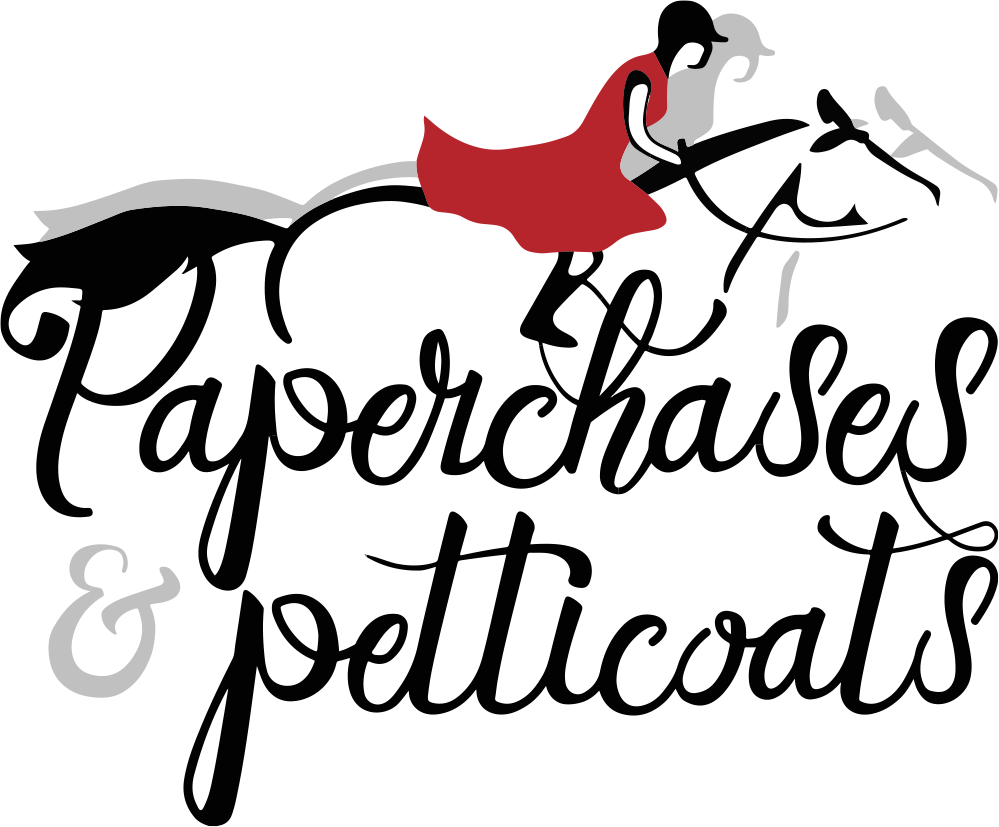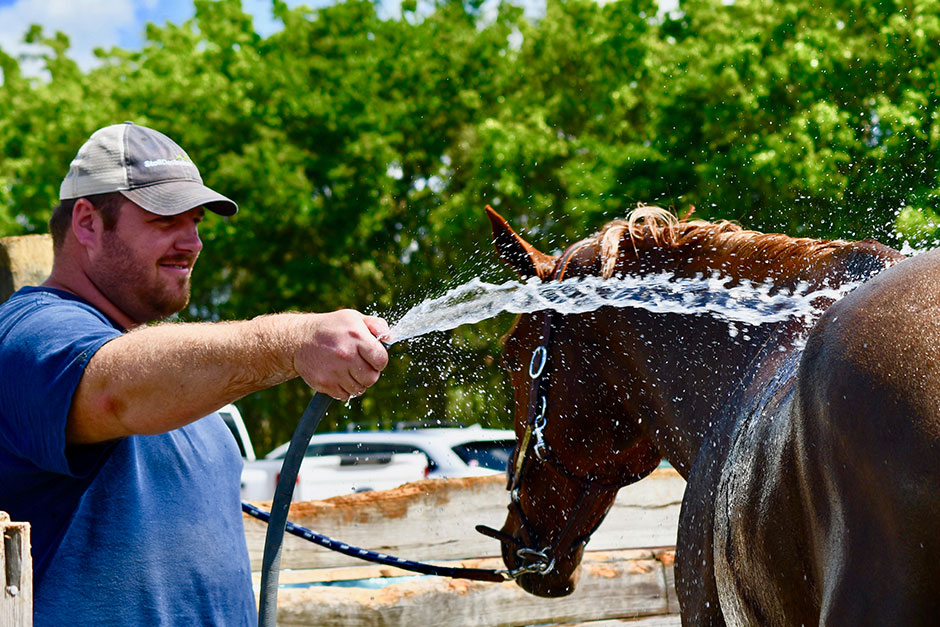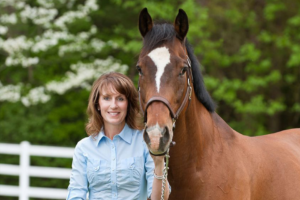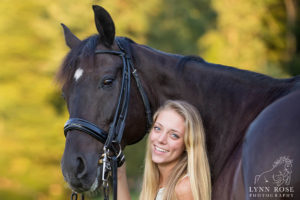For Tim Gaskell, working as a professional equine groom doesn’t seem like a career choice, but a fate that he could not resist. With over a decade of horse experience, Tim notes that his groom career has been a journey with many lessons learned, attesting that nothing comes easily. He can teach us all a thing or two about chasing our goals!
During this interview, Tim Gaskell shared some of the best grooming insight you’ll ever find.
1.What initially drew you to the world of professional horse grooming? Did you always know you wanted to be a professional horse groom?
I sort of just fell in on professional grooming. Having grown up with horses my whole life, it becomes just a routine thing to groom your horses. When I was old enough to start working for other people at 16, I had aspirations to train horses, or be a barn manager. At that time I wasn’t even on the radar of hunters or jumpers, but I started with Thoroughbreds, broodmares to be specific, and did night watch to wait for them to foal out. During the night I would get to know the mares by grooming them, pulling manes, and scrubbing muddy halters. Getting into hunters and jumpers starting in college and going to C shows, I saw the braided manes and fake braided tails for the first time, I thought it looked sharp and became really interested in the hunters. Skip ahead 4 years, I started the A circuit and was thrown into the world in Wellington and I never looked back. After 4 full seasons on the A circuit and perfecting my grooming, I officially fell in love with professional grooming and now I am in my second year of business, taking care of clients from all over the world in Wellington and throughout the USA.
2. What would you consider your “big break” in your career?
I would have to say that my big break was in 2016 during WEF week 10. I won the $1000 Shapley’s Grooms Class and I feel that it solidified my name as a top Groom in the nation. I took that win and ran with it to leave my full time job and start my business 7 months later.
3. How do you market your business?
In the beginning I really got a lot of local business by word-of-mouth. Once I hit a plateau with that I branched out. Now for marketing I use Social Media, a few of my bigger barns have a banner that they hang at the shows, and I have one ad out in a magazine. Social Media though has really helped get a lot of my bigger barns, and even several international clients. Most people admit that they have been stalking me and my work on Instagram or Facebook for several months before they call me. Follow my Instagram @tim_the_clipper_guy or my Facebook page TAG Equine Services LLC.
4. When you were just starting out in the industry, were there any grooms you really looked up to, or any who took you under their wing to help you get your start?
I admire and admired all grooms and their work when I started professionally, and still do today. As I would walk to the show ring with my horses, I would watch the grooms along the way to see how they were grooming or what they had in their boxes. I did have a few people help me out along the way and would love to give them shoutouts. Dana Miller, who worked for Andis Clippers at the time, showed me some awesome techniques and let me try out different clippers to see what I was comfortable with. Adam Smith and Dana Bordaleau, both braiders who always gave me different tips and encouraged me and helped me to be a great groom. They would tell me what they saw in different boxes in other barns and I could always call them if I needed anything. Colleen McTighe, Vet Tech master who always gives me advice and support, and always keeps me informed of the latest rules. When I won the grooms class, she told me about a great idea for vet wrap and elastikon and I’m convinced it helped me to win. Sally Burdette of Shapley’s, she always encourages me and encouraged me to step up and participate in their Grooms Class. After winning the Grooms Class, I reached out to Sally and Shapley’s to talk about working with them and representing them and it was one of the best decisions I have made.
5. What types of people make good grooms?
I believe that you can be anything that you want to be in life. Certainly if you are not a professional groom and have aspirations to be one, if you are will to sacrifice blood, sweat, and tears, you can be a groom and really anything you want. It does take a different kind of grit to be a pro groom though. Dedication 24/7, amazing observation skills, basic anatomy and horse medical skills, being proactive, good time management, being punctual, professionalism, are just a few of the basic skills you need to be a groom. You need to be flexible and know that everything can change in a minute and you have to be ok with that.
6. Can you tell us about a memorable experience you’ve had in the show ring?
Ah so many memories and so many great horses! What makes it worth it is when you see the riders happy and when the horses love their job. It’s not always about the lights, the money, or the ribbons, but I would have to say when I see the young horses that I have helped with over the years, get their moments in the big rings and do well, those are my favorite moments. Seeing a young horse come up through the ranks is one of my favorite things in this industry.
7. How do you prepare for a groom’s class?
Wow how do you not prepare? Making sure the tack fits properly and is perfectly clean, all the way down to the stirrup pads. Make sure your box or bag is sparkling and make sure you can carry everything except for the kitchen sink. If you think you will need it in the ring, then you need to carry it. Your horse needs to be clipped and groomed perfectly, but don’t overuse product because the judges will rub your horse and rub their hands to see how clean they are. Those girth straps need to be white and clean or not cracked if they are leather. Show them you take care of your rider too with a bottle of water and their spurs, and make sure your horse has a nice treat in that box.
8. How many horses do you see per week?
On average I body clip about 20 – 25 horses per week. Freelance grooming gives me 6 – 8 horses per week for when I’m showing. I also usually regularly groom and treat another 5-8 horses per week.
9. Whose horse have you not worked on but would love to?
I have a lot of amazing clients with amazing horses that I never dreamed I would ever be able to work on, but I would love to get to work on HH Azur, Gazelle, and even though he is retired, Cortes C.
10. Any favorite horse grooming disaster-saving stories that you’re most proud of?
One of my favorite things about running a grooming business is that I just have to wait for the phone to ring. By that I mean when people say I’m too expensive or some other excuse, they use another groom that gives their horse a terrible clip and an even equally terrible experience, then I get a call a few weeks later or even a year later to ask when I can come out to work on their horse. Recently I saved a pony from a mom and daughter DIY clip. Now I am proud that they started and had the ambition to start clipping the pony, but I wish they would have at least called me to teach them how to body clip the pony. I went to the PBIEC where the pony was and clipped him that night and he showed the next day. Good thing I use a shorter blade that made all of the lines and patches go away. The number one question I get is if it will be cheaper for a fix. My answer is always no because I still have to go over the entire horse to fix everything. Lucky I don’t charge more.
11. Which products are always in your grooming kit? Does it vary whether you’re at home or a show?
Shapley’s is there for me at home, at shows, and even when I travel. The simple labeling is a reflection of the simple and gentle cleaning products in those shampoo bottles. It works. Period. Horses are healthy and slick and no matter what situation I need to get a horse out of grooming wise, Shapley’s has the answer.
12. What’s your favorite off-label use for an equine grooming product?
I think I can relate with my other Pro Groom colleagues, when I rub a horse down with Sore-No-More, I will also rub it into my legs and hands to help with the aching that comes with being on your feet all day.
13. What’s your biggest horse grooming peeve?
Grooming. Good grooming practices are so important not only to their looks in the ring, but in their everyday health. I can always look at a horse and tell if it is not properly groomed or not groomed regularly. Curry, soft brush, hard brush, wet towel, hoof pick, mane comb. Those are the basic tools you need to groom your horse everyday. Do it.
14. Have you taken any big grooming risks?
You have to take risks to get better. I didn’t know how to properly braid until last year and I have been grooming for a long time. So I read some articles and watched some videos and just started braiding one day. The horse had a 1.30 Class. I told the owner that I’ve never braided before and was given a blank stare. I said don’t worry it will look great. I just started braiding and it turned out awesome for the class and I just keep practicing.
For clipping, because of scheduling conflicts, I had to clip a 5* horse the night before his jog. This horse was notorious for skin issues, so I pulled out all of the stops with longer blades, FEI approved Shapley’s shampoo after the clip, and then some oil to slick the coat right back up. It was one of my best clips ever and the horse looked amazing and passed his jog with flying colors!
15. What are your goals for the future?
To be better than I was yesterday. I always look to improve and learn something new everyday. I want to expand my business to train grooms how to work properly around horses and to keep the base of the Equine Industry strong and educated. I want to keep grooming at a high standard and to help every horse always look their best.




